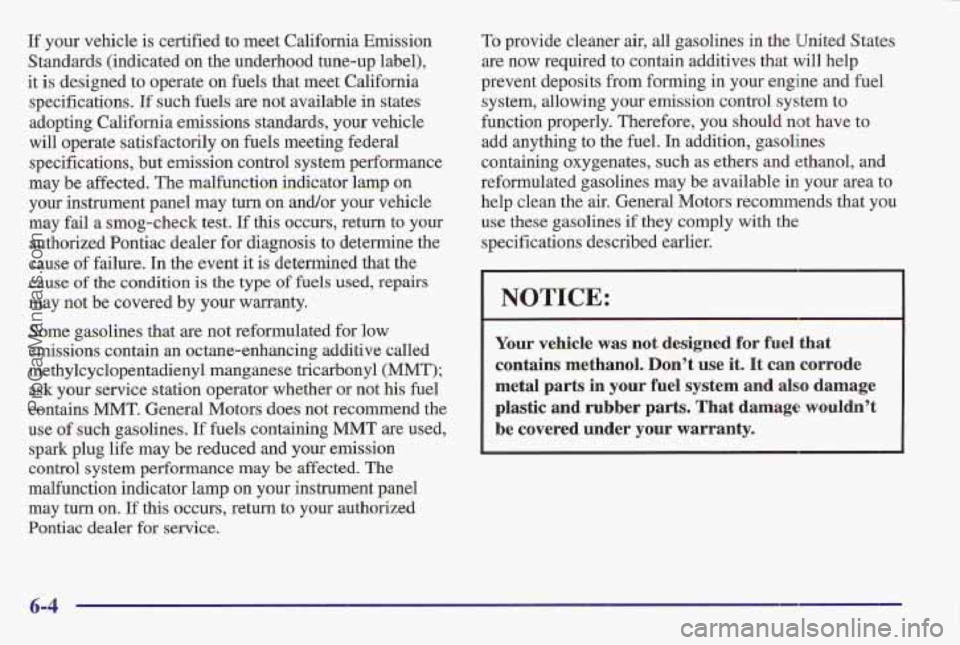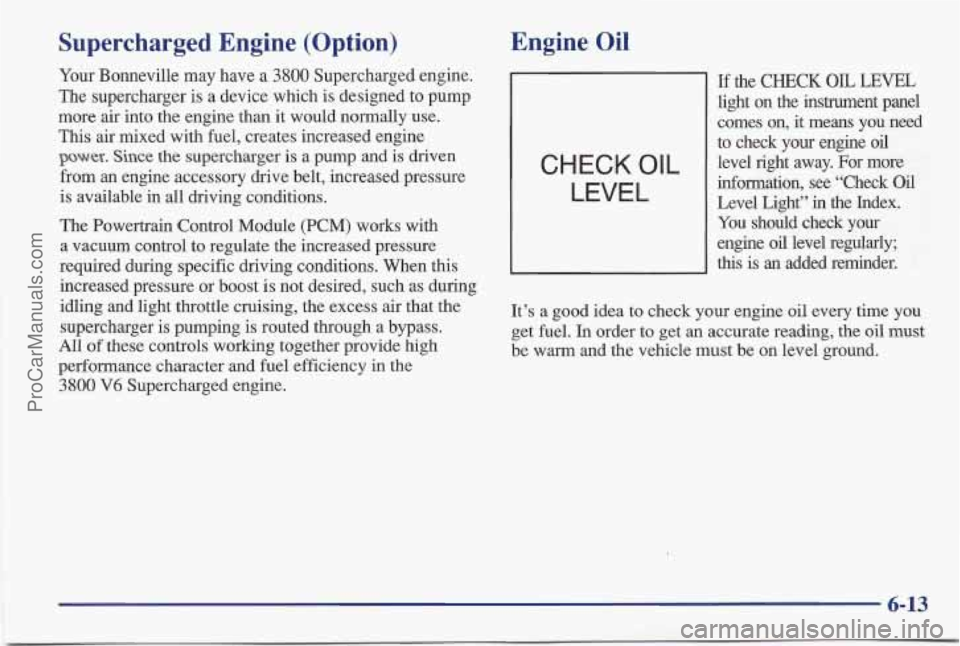Page 256 of 405

Adding Equipment to the Outside of
Your Vehicle
Things you might add to the outside of your vehicle can
affect the airflow around it. This may cause wind noise
and affect windshield washer performance. Check with
your Pontiac dealer before adding equipment to the
outside of your vehicle.
The 8th digit
of your vehicle identification number
(VIN) shows the code letter for your engine.
You will
find the VIN at the top left
of your instrument panel.
(See “Vehicle Identification Number” in the Index.)
If
you have the 3800 engine (VIN Code K), use regular
unleaded gasoline rated at
87 octane or higher. If you’re
using fuel rated
at the recommended octane or higher
and you still hear heavy knocking, your engine needs
service. But don’t worry
if you hear a little pinging
noise when you’re accelerating or driving
up a hill.
That’s normal, and you don’t have to buy a higher
octane fuel to get rid of pinging. It’s the heavy, constant
knock that means you have
a problem.
If you have the 3800 Supercharged engine (VIN Code
l), use premium unleaded gasoline rated at 91 octane
or higher. With the
3800 Supercharged engine, in an
emergency, you may be able
to use a lower octane -- as
low as
87 -- if heavy knocking does not occur. If you
are using 91 or higher octane unleaded gasoline and you
still hear heavy knocking, your engine needs service.
At
a minimum, the gasoline you use should meet
specifications
ASTM D48 14 in the United States and
CGSB 3.5-M93 in Canada. Improved gasoline
specifications have been developed by the American
Automobile Manufacturers Association (AAMA) for
better vehicle performance and engine protection.
Gasolines meeting the AAMA specification could
provide improved driveability and emission control system protection compared to other gasolines.
Be sure the posted octane for premium is at least 91
(at least 89 for middle grade and 87 for regular). If the
octane is less than 87, you may get a heavy knocking
noise when you drive.
If it’s bad enough, it can damage
your engine.
ProCarManuals.com
Page 257 of 405

If your vehicle is certified to meet California Emission
Standards (indicated on the underhood tune-up label),
it is designed to operate on fuels that meet California
specifications. If such fuels are not available in states
adopting California emissions standards, your vehicle
will operate satisfactorily on fuels meeting federal
specifications,
but emission control system performance
may be affected. The malfunction indicator lamp on
your instrument panel may turn on and/or your vehicle
may fail a smog-check test,
If this occurs, return to your
authorized Pontiac dealer for diagnosis
to determine the
cause of failure. In the event
it is determined that the
cause of the condition is the type of fuels used, repairs
may not be covered by your warranty.
Some gasolines that
are not reformulated for low
emissions contain an octan'e-enhancing additive called
methylcyclopentadienyl manganese tricarbonyl
(MMT);
ask your service station operator whether or not his fuel
contains
MMT. General Motors does not recommend the
use
of such gasolines, If fuels containing MMT are used,
spark plug life may be reduced and your emission
control system performance may be affected. The
malfunction indicator lamp on your instrument panel
may turn
on. If this occurs, return to your authorized
Pontiac dealer for service. To provide 'cleaner air, all gasolines in
the United States
are now required
to contain additives that will help
prevent deposits from forming in your engine and fuel
system, allowing your emission control system
to
function properly. Therefore, you should not have to
add anything to the fuel. In addition, gasolines
containing oxygenates, such as ethers and ethanol,
and
reformulated gasolines may be available in your area to
help clean the air. General Motors recommends that you
use these gasolines if they comply with the
specifications described earlier.
NOTICE:
Your vehicle was not designed for fuel that
contains methanol. Don't use it. It
can corrode
metal parts in your fuel system and also damage
plastic
and rubber parts, That damage wouldn't
be covered lander your warranty.
ProCarManuals.com
Page 260 of 405
I
A CAUTION:
2
If you get gasoline on yourself and then
something ignites it, you could be badly burned.
Gasoline can spray out on you if you open the
fuel filler cap too quickly. This spray can happen
if your tank is nearly full, and is more likely in
hot weather. Open the fuel filler cap slowly and
wait for any “hiss” noise to stop. Then unscrew
the cap all the way.
If you have the (L36) 3800 V6 engine, your fuel cap
will be tethered and you cannot hang it on the inside fuel
door while refueling.
To take off the cap, turn it slowly to the left
(counterclockwise). Be
careful not
to spill gasoline. Clean gasoline from
painted surfaces as soon as possible. See “Cleaning the
Outside of
Your Pontiac” in the Index.
6-7
ProCarManuals.com
Page 262 of 405
Checking Things Under the Hood
The following sections tell you how to check fluids,
lubricants and important underhood parts.
An electric fan under the hood can start up and
injure
you even when the engine is not running.
Keep hands, clothing and tools away from any
underhood electric fan.
A CAUTION:
F-
Things that burn can get on hot engine parts and
start
a fire. These include liquids like gasoline,
oil, coolant, brake fluid, windshield washer and
other fluids, and plastic or rubber. You or others
could be burned. Be careful not to drop or spill
things that will burn onto
a hot engine.
ProCarManuals.com
Page 264 of 405
3800 Series I1 Engine (L36 - Code K)
When you open the hood, you’ll see:
A. Engine Coolant Recovery Tank
B. Battery
C. Radiator Pressure Cap
D. Engine Oil Dipstick G. Brake Master Cylinder
E. Engine Oil Fill Cap H. Air Cleaner
E Automatic Transaxle Fluid Dipstick I. Windshield Washer Fluid Reservoir
6-11
ProCarManuals.com
Page 265 of 405
3800 Supercharged Engine (L67 - Code 1) (Option)
When you open the hood, you'll see:
A. Engine Coolant Recovery Tank D. Engine Oil Dipstick G. Brake Master Cylinder
B. Battery
E. Engine Oil Fill Cap H. Air Cleaner
C. Radiator Pressure Cap E Automatic Transaxle Fluid Dipstick I. Windshield Washer Fluid Reservoir
6-12
ProCarManuals.com
Page 266 of 405

Supercharged Engine (Option)
Your Bonneville may have a 3800 Supercharged engine.
The supercharger is a device which is designed to pump
more air into the engine than
it would normally use.
This air mixed with fuel, creates increased engine
power. Since the supercharger is a pump and is driven
from an engine accessory drive belt, increased pressure
is available in all driving conditions.
The Powertrain Control Module (PCM) works with
a vacuum control to regulate the increased pressure
required during specific driving conditions. When this
increased pressure or boost
is not desired, such as during
idling and light throttle cruising, the excess air that the
supercharger is pumping is routed through a bypass.
AI1 of these controls working together provide high
performance character and fuel efficiency in the
3800 V6 Supercharged engine.
Engine Oil
CHECK OIL
LEVEL
If the CHECK OIL LEVEL
light on the instrument panel
comes on, it means you need
to check your engine
oil
level right away. For more
information, see “Check
Oil
Level Light’’ in the Index.
You should check your
engine
oil level regularly;
this is
an added rerninder.
It’s a good idea to check your engine oil every time you
get
fuel. In order to get an accurate reading, the oil must
be warm and the vehicle must be on level ground.
6-13
ProCarManuals.com
Page 267 of 405
The engine oil dipstick is
lo'cated behind the engine
fans and in front
of the
engine
oil fill cap. The top
of the dipstick is-a round,-
yellow loop.
Turn off the engine and give the oil a few minutes to
drain back into the oil pan.
If you don't, the oil dipstick
might
not show the actual level.
Checking Engine Oil
Pull out the dipstick and clean it with a paper towel or
cloth, then
push it back in all the way. Remove it again9
keeping the tip down, and check the level.
6- 14
ProCarManuals.com